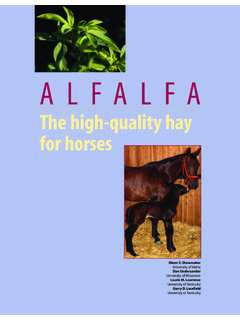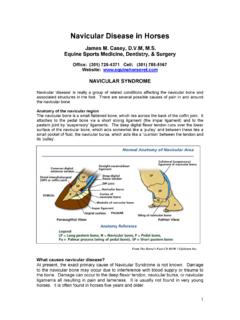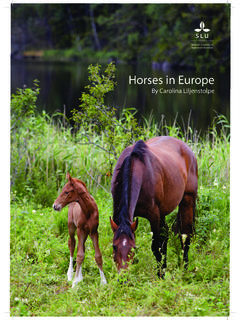Transcription of Alfalfa for Horses: The High-Quality Hay for Horses
1 The High-Quality hayfor horsesALFALFAG lenn E. Shewmaker University of Idaho Dan UndersanderUniversity of WisconsinLaurie M. LawrenceUniversity of Kentucky Garry D. LacefieldUniversity of KentuckyAlfalfa is often the pre-ferred forage for horsesbecause of its highquality, high digestibility,and good roughagevalue. Well-preserved Alfalfa hay shouldbe the foundation of a feeding programfor young growing Horses , recreationalhorses, and active Horses . This publica-tion describes the horse s digestivesystem and nutritional needs and howto select Alfalfa hay. It provides informa-tion on purchasing, storing, and feedingalfalfa hay; and uses science to discussmyths and realities of feeding horse s digestive systemHorses evolved as grazing to most other non-ruminant species, the horse has arelatively small stomach, a normal-sizedsmall intestine, and an enlarged hind gut(figure 1). This arrangement makeshorses better adapted to grazing contin-uously than to eating one or two largemeals a day.
2 Compare the size of a horse sstomach (figure 2) to the volume of haya horse will consume in a day, and it seasy to see why Horses should be allowedaccess to forage throughout the especially forage passes rela-tively rapidly through the stomach andsmall intestine, but can be retained formany hours in the hind gut (cecum). Thehind gut is populated by a diversemicrobial population that digests thefibrous components of hay and horse s digestive tract is generallynot as efficient at digesting fiber as thedigestive tract of a cow or , for High-Quality hays such asearly bloom Alfalfa hay, the difference ismuch smaller than for lower quality hayssuch as late-maturity grass hay (or pasture) can be anexcellent source of nutrients for mostclasses of Horses , and in most casesshould be the predominant type of feedin a horse s diet. However, some classesof Horses will require supplementationof their diet with a concentrate. A con-centrate feed can be a plain grain suchas oats or corn, or it can be a commer-cially manufactured mixture of grainsand other feed ingredients.
3 Concentratefeeds are higher in energy than haybecause the cereal grains contain morenonstructural carbohydrates, intestinecolonliverhearttracheaFigure digestive tract and internal organs of the model of a horse s stomach from an 1100-lb horse shownnext to the daily ration (15 lb) of hay. Because of their relatively smallstomachs, Horses are better adapted to eating forage all day longinstead of eating one or two large meals each day. In Horses , starch can be digested in thesmall intestine and absorbed as has demonstrated that whenlarge amounts of starch are fed, thecapacity of the small intestine to digestthe starch will be overloaded. The undi-gested starch is moved on to the largeintestine where it is of starch in the large intes-tine is less energetically efficient thandigestion and absorption from the smallintestine. More importantly, fermenta-tion of excess starch in the large intes-tine can result in digestive problemssuch as diarrhea, colic, and, in severecases, an 1100-lb horse consumes ameal containing more than lb ofstarch, there is potential for some undi-gested starch to reach the large intes-tine.
4 Cereal grains vary in starch content,so the actual amount of grain that canbe fed without starch by-passing to thelarge intestine will vary also. Corn cancontain 60 70% starch whereas oatscontain 45 55% starch. Many commer-cially manufactured feeds will have astarch content of 45 55%, althoughfeeds with lower amounts of starch arebecoming more available. If a horse isfed a concentrate containing 50% starch,the amount that could be fed in a singlemeal with minimal starch by-pass to thelarge intestine would be lb. There-fore, when the daily concentrate intakeexceeds 10 lb, the concentrate should bedivided into three meals per the nutritional needsof horsesHorse nutrient needs change withage and production state. Veryyoung Horses usually require themost nutrient-dense diets because theyare growing rapidly. The diets have to benutrient dense to meet the animal s highnutrient requirements and limited intakecapacity. As Horses age, diets that areless nutrient dense are usually mares and Horses with strenu-ous physical activities have much higherrequirements than Horses that are keptat maintenance or are used for lightrecreational 1 shows the approximate amountsof several nutrients required by Horses indifferent physiological stages on a dailybasis.
5 These values may need to beadjusted for specific Horses , particularlyif they are exposed to unusually hot orcold weather. For some nutrients, theapproximate dietary concentrations arealso shown. These concentrations arebased on average expected feed intakesof the Horses in each physiological accurately determine the appropriatedietary concentration for a nutrient, it isnecessary to know the feed intake of thehorse. For example, if a horse consumes25 lb of feed per day and it requires 2 lbof crude protein, then the feed mustcontain 8% crude protein (2 25).However, if the horse only consumes 20lb of feed per day, then the feed mustcontain 10% crude protein to providethe needed crude protein each Horses will consume at least 2 lb offeed (forage and concentrate, 90% drymatter) for every 100 lb of body , if very low- quality forage isfed, feed intake might be , if highly palatable feed isoffered, intake may increase. Somehorses, especially lactating mares andgrowing Horses , may consume 3 lb offeed per 100 lb of body High-Quality HAY FOR HORSESC lass Digestibleof horseenergy**Crude proteinCalciumPhosphorusMcal/lb/% ing/% in g/% in *Expressed as total daily intakes or dietary concentration on a 100% dry matter basis.
6 **Digestible energy = (gross energy of food) (energy lost in feces)Source: Adapted from NRC (1989) Nutrient Requirements of Horses Table 1. Recommended nutrient intakes for Horses with an expected mature body weight of 1100 lb.*Typical dry matter intakes (per 100 lb ofbody weight) for Horses are shown intable 2. Also shown are the amounts ofdry matter from forage and concentratein typical diets. Forage should be thecornerstone of horse diets, comprisingthe largest part of the dry matter intakeas a guard against energy-dense feedssuch as starch, to meet the need forlarge particle size for fiber requirement,and for continuous supply of guidelines for feed intake are bestapplied when mid-maturity forage isused. When early-maturity forage isused, the amount of concentrate in thediet can usually be reduced, whereaswhen late-maturity forage is used, moreconcentrate will be Horses used forrecreational activitiesMany Horses are used for recreation(which includes weekend riding, occa-sional showing, and similar activities)where the horse is exercised at a low tomoderate intensity for less than 5 hoursa week.
7 In general, these Horses have lowto moderate nutrient requirements andnutrient deficiencies are relatively , the biggest nutritionalproblem facing these Horses is excessnutrient intake, especially calories, whichcan result in 3 shows two diets using Alfalfa haythat will meet, or slightly exceed, theneeds of a mature 1100-lb horse usedfor recreational riding. Both diets meetthe nutrient needs of the horse, butwhich diet is best? One considerationmight be cost. Another considerationmight be total feed intake. Total feedintake is highest when diet A is used. Thelower feed intake with diet B could bean advantage if you have a picky , diets with low feed intakesoften mean more idle time for thehorses (especially those confined installs or small paddocks) and increasedpotential for stall vices such as woodchewing. Because these diets use alfalfahay as the forage source, they providemore protein and calcium than arerequired for recreational Horses .
8 Mostnutritionists agree that exceeding theprotein and calcium requirements is notharmful for normal healthy dryForageConcentrateClass of horsematter intake (lb)intake (lb)intake (lb) (last trimester) : Adapted from NRC (1989) Nutrient Requirements of Horses Recreational horse*Lactating mare**Diet A (lb)Diet B (lb)Diet A (lb)Diet B (lb)Bud stage Alfalfa hay019180 Full bloom Alfalfa hay24008 Mature timothy hay0007 Commercial concentrate**00813 SaltFree choiceFree choiceFree choiceFree choice* Note that diet B for a recreational horse provides feed intake below 2 lb /100 lb of body weight.** Using a typical commercial concentrate formulated for lactating mares containing at least14% CP, Ca, P, 30 ppm Cu, 80 ppm Zn, and ppm dry matter intakes by Horses (lb DM/100 lb of body weight).Table diets that meet the needs of recreational Horses * (1100 lb)and lactating mares (1100 lb).
9 When good- to High-Quality forages areoffered free choice, some recreationalhorses will get fat. These forages are notonly more digestible and more nutrientdense than later-maturity forages, theyare also usually more palatable, sohorses will eat more. An 1100-lb geldingoffered early (1 10bloom) Alfalfa hay freechoice might consume as much as 25 to30 lb per day! This would exceed hiscalorie requirements by about 50 60%and could result in a weight gain of 150to 200 lb in a year! To keep Horses attheir ideal weight, it s best to feed themlower- quality hay or limit their access tovery High-Quality nutrition plays an important rolein reproductive efficiency and is a keycomponent of broodmare in early gestation havenutrient requirements at, or just slightlyabove, maintenance, and may be feddiets similar to those recommended forrecreational Horses . However, after about8 months of gestation their nutrientrequirements increase. If additionalnutrients are not available from the diet,mares will mobilize their own bodystores to meet the needs of fetal devel-opment.
10 As shown in table 2, feed intakein pregnant mares may fall below 2 lbper 100 lb of body weight near the endof gestation. This reduction in feedintake may require an adjustment to thediet to ensure that nutrient needs aremet. Once a mare foals, her nutrientneeds increase greatly compared to ges-tation (table 1). Again, if nutrientdemand for milk production is not met,the mare will mobilize body condition (fatness) can affectreproductive efficiency in mares. A con-dition scoring system has been devel-oped for Horses that scores Horses from1 to 9, where 1 is an extremely thinhorse and 9 is an extremely fat in moderate body condition(condition score = 5) have ribs that arenot visible, but can be easily felt and areeasier to breed than mares with bodycondition scores below 5. Mares with abody condition score of 6 have a reserveof fat that can be used if the weatherturns cold or if they are unable toconsume enough feed to meet theirrequirements in late gestation or lacta-tion.










